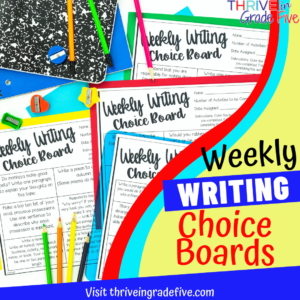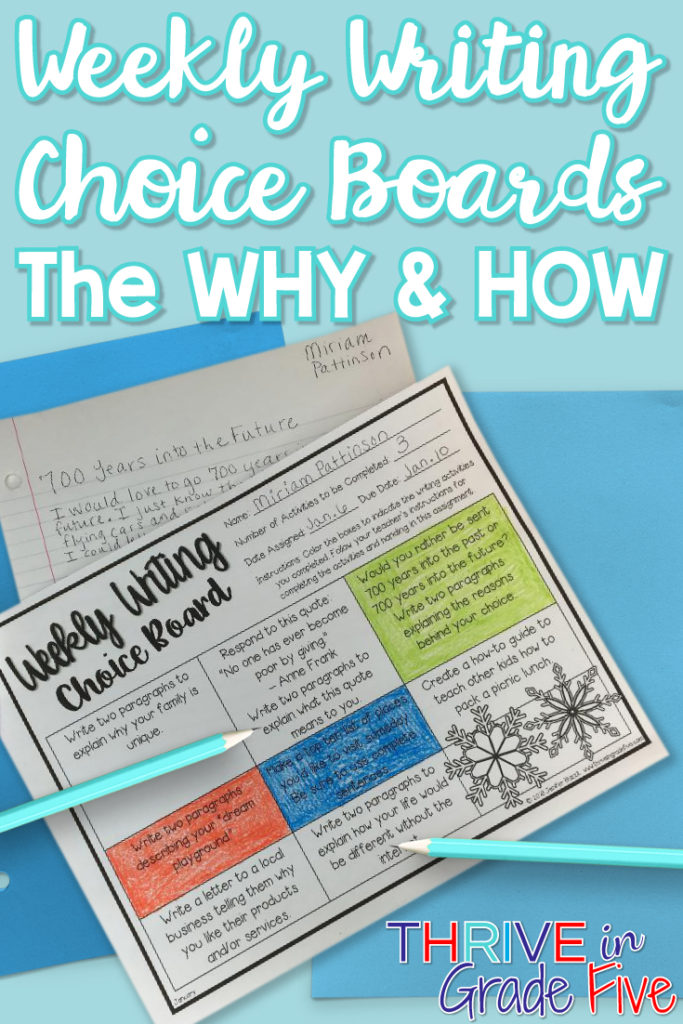What are Weekly Writing Choice Boards and how will they boost your students’ writing skills? Read on to find out!
Do you dread giving your students a writing assignment because you don’t want to hear the whining? I’ve been where you are!
Students become top-notch writers by writing in a wide variety of genres, about many different topics, and this is important… writing all.the.time.
So, my goal in this blog post is to give you practical ideas to help you get those pencils moving in your classroom!
I’d love to send you a sample of my Weekly Writing Choice Boards. Enter your first name and email address below. You’ll also become a member of my upper elementary teacher email club!
Why are many students reluctant writers?
There are a million reasons for this but one thing I’ve noticed over the years is that some students tend to see writing as a chore… a boring academic chore.
I’ve always worked in lower-income schools and it’s the same thing every year. Lower grade teachers are required to push reading and math, so when students come to my 5th grade classroom, they haven’t had much experience with writing and it’s usually something they don’t want to do.
How do I make my students fall in love with writing?
I do this in two ways: Giving Choices and Providing Structure!
We don’t jump right into heavy-duty writing at the beginning of the school year. Instead, I assign lots of choice-based writing, i.e. Weekly Writing Choice Boards.
Further into the school year, we move to more structured writing, specifically Five Paragraph Essays.
But I do keep the Weekly Writing Choice Boards going all year for consistency and because students truly enjoy the boards.
Let’s Talk About Giving CHOICES…
Engagement is EVERYTHING.
A student who is interested in the lesson is bound to be a better learner than a student who doesn’t care.
So, how can we increase engagement in our students? CHOICE
When given options, students immediately have some agency over what they’re learning.
They’re not being told what to do, they get to decide what to do – this is critical with upper elementary students.
Learners are more excited about learning when they have some decision-making power.
However, giving options doesn’t mean saying “do whatever you like,” because our students need structure, too.
How can we give them choices while retaining some structure? After all, we have a curriculum to follow, schedules to keep, and administrators to whom we answer.
It can be overwhelming. Still, there are ways to integrate choice into writing curriculum while continuing to meet state standards. If this sounds like too daunting a task, you’re in luck, because it’s all been done for you here.
What other benefit does choice bring to learning? Higher engagement leads to deeper learning, and more on-task behavior. That means fewer classroom management issues. BOOM.
A writing choice board with relevant, well-thought-out prompts like these will help your students grow as writers and learners.
Incorporate a choice board into your academic day – you’ll see the benefits – and so will your students!
How to Create Weekly Writing Choice Boards
All you have to do is create a list format or a grid format, add the writing choices, and make it clear how many assignments you expect from students per week.
The image below shows the Weekly Writing Choice Boards that I create for my students:

Be sure to include a variety of writing choices on your weekly boards, including lists, letters, fiction, nonfiction, opinion, narrative, informative, sequential order writing, and etc.
I would love to share a set of six free Writing Choice Boards with you! Enter your first name and email address below to have the file sent to you right away.
How to Assess Weekly Writing Choice Boards
Once I’ve given students writing choices and collected their weekly assignments, then I have to assess.
If you are imagining yourself sitting on the couch all weekend grading your students’ writing, you can put that out of your mind right now!
Contrary to what our teachers did when we were in school ourselves, you don’t need to make a million marks all over your students’ papers and correct every single spelling and grammar mistake.
Seriously, when teachers do that, they are spinning their wheels.
Students take one look at their marked up papers and immediately think, “I am a terrible writer. I give up.”
If you’d like to read more about how I grade my students’ writing, you’ll want to visit this post: Tips for Teaching and Grading Five Paragraph Essays.
I grade my students’ weekly writing using more of a holistic approach.
First of all, did they complete the required number of writing assignments?
Second, I look at the content of students’ writing. Did they stay on topic? Does their writing make sense? Is it engaging? Is it easy to read?
Finally, I assign a grade of 100, 90, 80, 70, or 60. This is quite subjective but I can always back up my grades with why I felt that a particular assignment deserved the grade it received.
This will become second nature to you because you’ll be completing this same assessment process every week.
That’s all for now, teacher friends! I would love to see your comment below telling us how you use weekly writing choices in your classroom!








